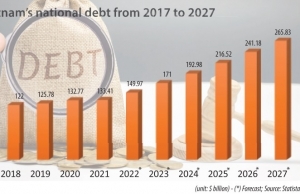INTERNATIONAL INVESTMENT
AND PORTAL
Throughout the first half of this year, many banks – particularly smaller entities – have witnessed a sharp reduction in their profits.
In the first six months of this year (H1), BaoViet Bank posted $1.05 million in pre-tax profit, equal to just 26 per cent of its full-year projection – which is set at $4 million.
Similarly, ABBank saw a 59 per cent plunge in its pre-tax profit during the period, falling to $28.6 million and reaching only 24 per cent of its full-year plan.
Meanwhile, the figures at VietA Bank approximated $23.6 million, down 11 per cent on-year and equal to 41 per cent of the annual plan.
VietA Bank has attributed lower profit figures to a raft of factors, including an 87 per cent reduction in earnings from other services, which fell to just $1.64 million in H1 of this year.

Its non-interest income sources were also diminished, with earnings from forex trading decreasing by 76 per cent and stock trades also reporting losses.
Adding to the challenges, operating expenses rose 20 per cent, reaching $18.39 million. The bank also put $1.6 million into its provisioning fund, up 2.7-fold compared to one year ago.
As of June 30, BaoViet Bank's non-performing loans reached $74.09 million, soaring by 58 per cent since January. Of these, debts that risk being lost accounted for 87 per cent of the total.
Banks with strong capital buffers could eye profit growth ranging from 18-20 per cent, surpassing the sector’s average level.
Consequently, its bad debt ratio rose from 3.34 per cent to 4.69 per cent during the period.
At ABBank, its sharp fall in profits were again due to a range of factors, such as its net interest income falling by 13 per cent in H1 to just $66.1 million, operating expenses shooting up by 17 per cent to nearly $46 million, and a 3.7-fold increase in its provisioning sum, which soared to $34.3 million.
As of June 30, major state lender Vietcombank continued to take the lead in respect to its loan loss coverage ratio, which reached 387 per cent, up 70 per cent compared to the start of the year. This more than doubled the second top performer, VietinBank, with a coverage ratio of 169 per cent.
This is one of the reasons why Vietcombank only reached 47 per cent of its full-year profit projection, despite posting an 18 per cent hike in its pre-tax profits, which hit $864.9 million during the period.
Vietcombank Securities JSC (VCBS) has forecast that the banking sector’s pre-tax profit will inch up by about 10 per cent in 2023, a remarkable reduction compared to the average profit growth of nearly 35 per cent seen last year.
The VCBS forecast also depicts a division in the profit outlook at different banking groups, and such gap could widen further in 2024.
According to VCBS, smaller banks might experience further slides in their growth – even reaching negative growth – amidst the worsening real estate market and global macroeconomic picture, leading to lower credit expansion and casting a shadow on customers’ solvency.
By contrast, banks with strong capital buffers could eye profit growth ranging from 18-20 per cent, surpassing the sector’s average level.
 Retail segment brightens bank profit picture
Retail segment brightens bank profit picture
Many banks have unveiled their third-quarter business results, showing a spike in their profits, leveraging well-conceived retail lending development strategy amid restricted credit line.
 Public debt management picture clears towards 2025
Public debt management picture clears towards 2025
Vietnam’s plan for borrowing and paying public debt has been revealed, and the budget landscape finalised for this year, with public debt set to stay within the permissible limit.
 Cement sector faces bleak prospects
Cement sector faces bleak prospects
According to the Ministry of Construction (MoC), the production and consumption volumes of several major building materials saw a sharp decline in the first half of this year, with cement, in particular, experiencing a considerable decline.
By Vinh Thuy



















